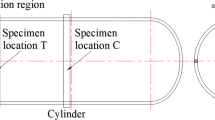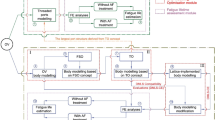Abstract
Burst tests are important when developing type IV hydrogen pressure vessels (HPVs). These tests are easy to conduct for fuel cell electric vehicle-type HPVs but challenging for tube-skid type IV HPVs for gas transport owing to limitations associated with the test equipment and space and intense explosive power requirements. Herein, a short-body HPV is proposed to promote the development of tube-skid type IV HPVs. Scale HPVs (original-body, short-body) were manufactured by applying a minimized pattern, which was generated via tow-prepreg property and structural analyses using Abaqus WCM. Thereafter, the hydrostatic pressure burst test was conducted on the scaled models, and the applicability of the short-body HPV to tube-skid type IV HPVs was evaluated. The experimental results confirmed the equivalence of the burst pressures between the original and short-body HPVs under the same pattern application conditions.




















Similar content being viewed by others
References
Hwang, J. S., Kim, J. H., Kim, S. K., & Lee, J. M. (2020). Effect of PTFE coating on enhancing hydrogen embrittlement resistance of stainless steel 304 for liquefied hydrogen storage system application. International Journal of Hydrogen Energy, 45(15), 9149–9161. https://doi.org/10.1016/j.ijhydene.2020.01.104
Bae, D. S., Lee, J. K., Lee, S. P., Jung, K. G., Hwang, S. G., & Lee, J. H. (2016). Nondestructive evaluation on hydrogen effect of 316 L stainless steel. International Journal of Precision Engineering and Manufacturing-Green Technology, 3(1), 99–103. https://doi.org/10.1007/s40684-016-0013-7
Leh, D., Magneville, B., Saffré, P., Francescato, P., Arrieux, R., & Villalonga, S. (2015). Optimisation of 700 bar type IV hydrogen pressure vessel considering composite damage and dome multi-sequencing. International Journal of Hydrogen Energy, 40(38), 13215–13230.
Lisbôa, T. V., Almeida, J. H. S., Jr., Dalibor, I. H., Spickenheuer, A., Marczak, R. J., & Amico, S. C. (2020). The role of winding pattern on filament wound composite cylinders under radial compression. Polymer Composites, 41(6), 2446–2454. https://doi.org/10.1002/pc.25548
Ke Chun, S., & Guang, P. (2018). Optimizing the buckling strength of filament winding composite cylinders under hydrostatic pressure. Journal of Reinforced Plastics and Composites, 37(13), 892–904. https://doi.org/10.1177/0731684418765989
Soden, P. D., Kitching, R., Tse, P. C., Tsavalas, Y., & Hinton, M. J. (1993). Influence of winding angle on the strength and deformation of filament-wound composite tubes subjected to uniaxial and biaxial loads. Composites Science and Technology, 46(4), 363–378. https://doi.org/10.1016/0266-3538(93)90182-G
Kastenmeier, A., Schmid, V., & Ehrlich, I. (2016). Specimen preparation and material characterization of filament wound composite tubes. Journal of Technology and Engineering, 4(3).
Alam, S., Yandek, G., Lee, R. C., & Mabry, J. (2021). A study of residual burst strength of composite over wrapped pressure vessel due to low velocity impact. International Journal of Pressure Vessels and Piping, 194, 104511. https://doi.org/10.1016/j.ijpvp.2021.104511
Ramirez, J. P. B., Halm, D., Grandidier, J. C., Villalonga, S., & Nony, F. (2015). 700 bar type IV high pressure hydrogen storage vessel burst—Simulation and experimental validation. International Journal of Hydrogen Energy, 40(38), 13183–13192. https://doi.org/10.1016/j.ijhydene.2015.05.126
Vasiliev, V. V., Krikanov, A. A., & Razin, A. F. (2003). New generation of filament-wound composite pressure vessels for commercial applications. Composite structures, 62(3–4), 449–459. https://doi.org/10.1016/j.compstruct.2003.09.019
Zu, L., Koussios, S., & Beukers, A. (2010). Design of filament–wound domes based on continuum theory and non-geodesic roving trajectories. Composites Part A: Applied Science and Manufacturing, 41(9), 1312–1320. https://doi.org/10.1016/j.compositesa.2010.05.015
Zu, L., Koussios, S., & Beukers, A. (2011). Integral design for filament-wound composite pressure vessels. Polymers and Polymer Composites, 19(4–5), 413–420. https://doi.org/10.1177/0967391111019004-525
Cho, S. M., Kim, K. S., Lee, S. K., Jung, G. S., Lee, S. K., & Lyu, S. K. (2018). Effect of dome curvature on failure mode of type4 composite pressure vessel. International Journal of Precision Engineering and Manufacturing, 19(3), 405–410. https://doi.org/10.1007/s12541-018-0048-5
Hill, R. (1948). A theory of the yielding and plastic flow of anisotropic metals. Proceedings of the Royal Society of London. Series A. Mathematical and Physical Sciences, 193(1033), 281–297. https://doi.org/10.1098/rspa.1948.0045
Tsai, S. W., & Wu, E. M. (1971). A general theory of strength for anisotropic materials. Journal of Composite Materials, 5(1), 58–80. https://doi.org/10.1177/002199837100500106
Hashin, Z. (1980). Failure criteria for unidirectional fiber composites. Journal of Applied Mechanics, 47(2), 329–334. https://doi.org/10.1115/1.3153664
Alam, S., Yandek, G. R., Lee, R. C., & Mabry, J. M. (2020). Design and development of a filament wound composite overwrapped pressure vessel. Composites Part C: Open Access, 2, 100045. https://doi.org/10.1016/j.jcomc.2020.100045
Bae, J. H., & Kim, C. (2013). Optimal design for compressed natural gas composite vessel by using coupled model with liner and composite layer. International Journal of Precision Engineering and Manufacturing, 14(2), 275–281. https://doi.org/10.1007/s12541-013-0038-6
Acknowledgements
This work was supported by the Technology Innovation Program-Key Technology Development of Automotive Industry Program (Green-Car) [No. 20007892, Development of tube-skid using pressure vessels(700Bar class 1400liters) made of towpreg with a single shipment for hydrogen of 1ton or more and a total weight of 20ton or less] funded by the Korea Evaluation Institute of Industrial Technology (KEIT, Korea) and the Ministry of Trade, Industry & Energy (MOTIE, Korea).
Author information
Authors and Affiliations
Corresponding author
Additional information
Publisher's Note
Springer Nature remains neutral with regard to jurisdictional claims in published maps and institutional affiliations.
Rights and permissions
Springer Nature or its licensor (e.g. a society or other partner) holds exclusive rights to this article under a publishing agreement with the author(s) or other rightsholder(s); author self-archiving of the accepted manuscript version of this article is solely governed by the terms of such publishing agreement and applicable law.
About this article
Cite this article
Hwang, JS., Ko, KH. & Jung, GS. Proposal of a Short-Body Hydrogen Pressure Vessel to Assess the Burst Performance of Long-Body/Large-Capacity Vessels. Int. J. Precis. Eng. Manuf. 24, 471–483 (2023). https://doi.org/10.1007/s12541-022-00757-5
Received:
Revised:
Accepted:
Published:
Issue Date:
DOI: https://doi.org/10.1007/s12541-022-00757-5




